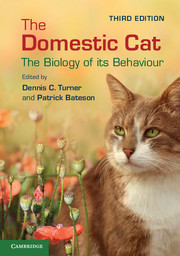Book contents
- Frontmatter
- Contents
- Contributors
- Abbreviations
- I Introduction
- II From Kitten- to Adulthood
- III Social Life and Ecology
- IV Cats and People
- V Cat Breeding and Cat Welfare
- 10 Feline welfare issues
- 11 Breed and gender behaviour differences: relation to the ancient history and origin of the domestic cat
- 12 Showing cats
- 13 Individual and environmental effects on health and welfare
- 14 Feline behavioural problems and solutions
- VI The Future
- References
- Index
12 - Showing cats
Published online by Cambridge University Press: 05 December 2013
- Frontmatter
- Contents
- Contributors
- Abbreviations
- I Introduction
- II From Kitten- to Adulthood
- III Social Life and Ecology
- IV Cats and People
- V Cat Breeding and Cat Welfare
- 10 Feline welfare issues
- 11 Breed and gender behaviour differences: relation to the ancient history and origin of the domestic cat
- 12 Showing cats
- 13 Individual and environmental effects on health and welfare
- 14 Feline behavioural problems and solutions
- VI The Future
- References
- Index
Summary
Introduction
The whole concept of different breeds of cat is a relatively modern one extending back only about 150 years. Other domesticated animals have a breed history much older; dogs and horses in particular were deliberately domesticated to ‘serve’ humans and were, to some extent, selectively bred from very early in their relationship with people to fit their needs. Thus the idea of selecting for different physical ‘types’, whether size, mass, speed, or certain mental abilities or characteristics is something human beings have pursued, albeit in a somewhat random way, probably for several millennia. By the eighteenth century this practice in some domestic species was quite refined, with a large number of recognisably different types of dogs, horses and, following the agricultural revolution from the mid eighteenth century onwards, of various farm animals such as cattle, sheep, pigs and fowl, all developed to meet different needs in human society. Deliberate selection had not yet been applied to the domestic cat, but by the latter half of the nineteenth century there was a growing understanding of basic genetics and as a result people realised they could select for, perpetuate and even improve certain attractive or distinctive features in domestic animals. Mendel’s findings on the principles of heredity were initially ignored, but by the beginning of the twentieth century were gaining acceptance. It was discovered, without the reasons being completely understood, that by breeding like to like or mating together closely related animals, offspring could exhibit the features particularly valued and sought after. Although the domestic cat has had a relationship with humans for at least 4000 years, this relationship has principally been one of exploitative captive, where the cat provided an effective control of rodents and other vermin in both urban and rural environments. In performing these functions the cat was regarded as extremely useful and gradually also respected as a companion animal (see Chapter 7).
- Type
- Chapter
- Information
- The Domestic CatThe Biology of its Behaviour, pp. 167 - 184Publisher: Cambridge University PressPrint publication year: 2013

